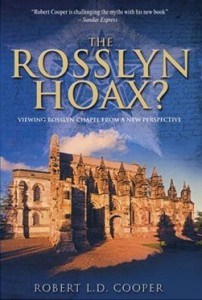The Rosslyn Hoax?
I has recently been announced that the book: The Rosslyn Hoax? has sold out in hardback and indeed such is the demand that the publishers have decided to publish a second, paperback, edition. This is in itself significant because less than 10% of all books first published in hardback succeed in making it into the paperback format. The success of the books seems due entirely to the knowledge of the author regarding Scottish Freemasonry and his expert analysis of the various theories offered by non-Freemasons on subjects which are within his professional remit. Such was the success of the book that copies reached north America even although it is not on sale there. Below is a review of the book by an eminent Masonic historian based in the USA. The paperback edition is due, we are informed, to be be published in June 2007.
The Rosslyn Hoax?
 How many times over the past twenty years have we purchased new books that attempt to rewrite the history of Freemasonry and Scotland? The myth of Freemasonry’s Templar origins is as old as the high degrees themselves. But prior to the early 1980’s a relative few had heard of the Templars or Rosslyn Chapel. The virtual explosion in popular books on these subjects can be traced back to the 1982 publication of the book: The Holy Blood, The Holy Grail by British authors Michael Baigent, Richard Leigh and Henry Lincoln.
How many times over the past twenty years have we purchased new books that attempt to rewrite the history of Freemasonry and Scotland? The myth of Freemasonry’s Templar origins is as old as the high degrees themselves. But prior to the early 1980’s a relative few had heard of the Templars or Rosslyn Chapel. The virtual explosion in popular books on these subjects can be traced back to the 1982 publication of the book: The Holy Blood, The Holy Grail by British authors Michael Baigent, Richard Leigh and Henry Lincoln.
It was followed by a confusing array of literally hundreds of other publications by an almost equal number of authors all wishing to add their own ‘discoveries’ to the mix, and each one eager to cash in on the public’s increasing thirst for answers to the questions and ‘mysteries’ unearthed in the previous books.
Today, one can hardly visit the local mega-bookstore, browse the inventory of online booksellers, or turn to a cable television channel, without being confronted with the latest twist on the increasingly entangled and convoluted histories of Freemasonry, the Knights Templar, the Holy Grail, the Shroud of Turin, the mysterious (if non-existent) Priory of Sion, The Da Vinci Code, the ‘Eye in the Pyramid’ etc. And they all seem to lead back to the common ground of Rosslyn Chapel just south of Edinburgh, and the St. Clair family. The authors of these books have written volumes about Freemasonry, especially, Scottish Freemasonry, but too often they simply get it wrong.
It is safe to say that no one would rejoice more at the discovery of real, solid, evidence supporting a Templar/Masonic connection in Scotland as Scottish Rite Masons. The Scottish Rite Supreme Council itself is, in effect, organized as a neo-Templar organisation. And a number of our Scottish Rite degrees celebrate the deeds of the medieval Knights Templar. But too often Masonic readers, like the general public, are tempted to eagerly embrace this new genre of pseudo-history without dispassionate consideration and critical analysis.
Robert L. D. Cooper, Curator of the Grand Lodge of Scotland Museum and Library, has spent over twenty years [we kid you not! – Ed.] researching for this book. Cooper, during this time has he has researched and answered thousands of enquiries [the ‘wonder’ of e-mail – Ed.] from all over the world on subjects as diverse as: The Kirkwall Scroll, famous Freemasons, so-called secret societies, the St. Clair family (he edited the acclaimed Genealogie of the Sainteclaires of Roslin), Scottish Freemasonry and, of course, Rosslyn Chapel. A comparison of the results of his research with the work of popular writers has exposed major differences between how Scottish Freemasons view their history and heritage and that described by those who are not Freemasons.
‘I thought that it was time for a Scottish Freemason to contribute to the discussion on Rosslyn Chapel and Freemasonry – with the hope of adding some clarity’, says Cooper.
In the conclusion of the book, Cooper answers the question in its title. He writes, ‘Yes, everyone has been hoaxed; not only the public but Freemasons themselves have been victims of a sustained attempt to make them out to be something they are not’.
The book, beautifully illustrated, includes 73 illustrations (by the author and his wife, Yvonne), nine (yes nine!) appendixes of transcripts of original documents relating to Scottish Freemasonry [it is exceptional that a modern book contains such a wealth of original material].
Pete Normand
Editor, Plumbline
The Quarterly Magazine of the Scottish Rite Research Society.
The paperback can be ordered from Amazon UK – click on the link below. Remember that you will leave this web site – use the back button!